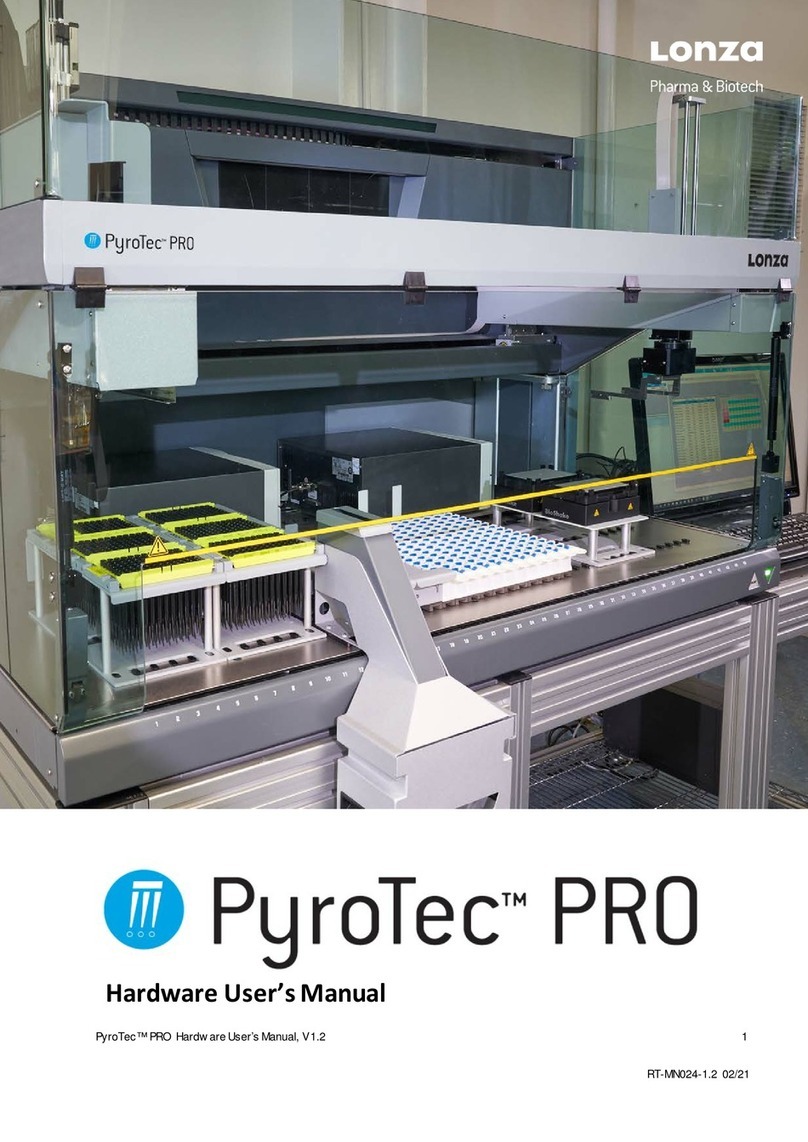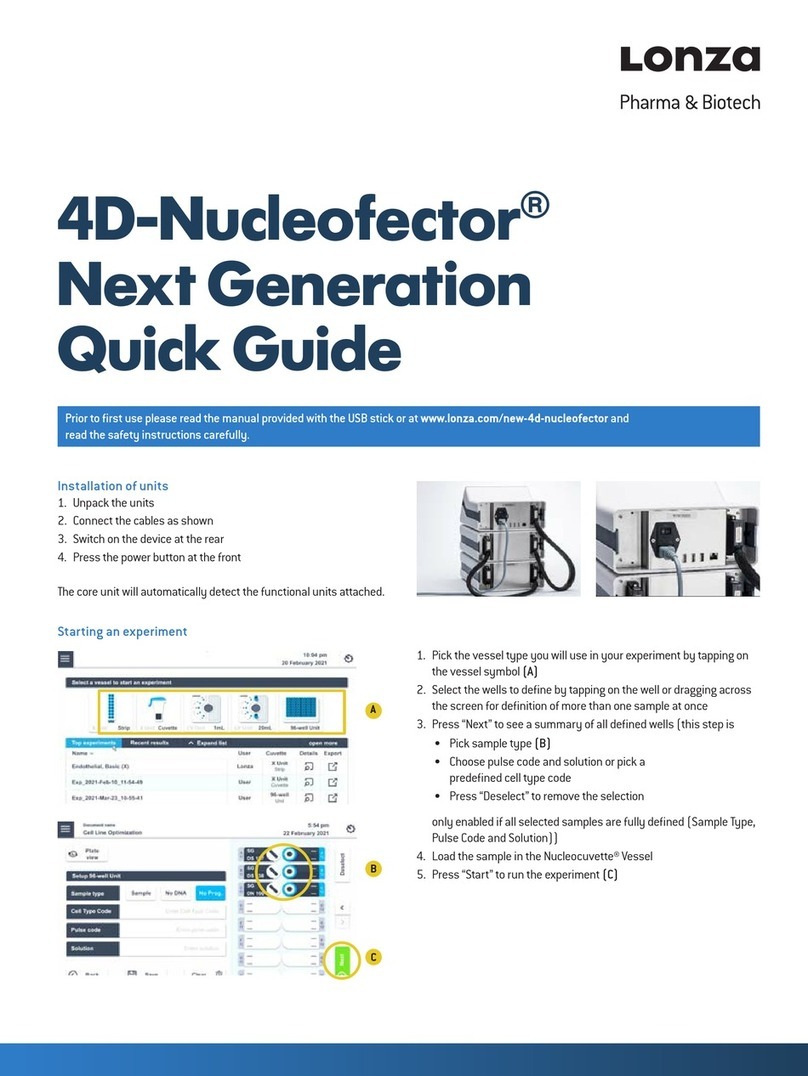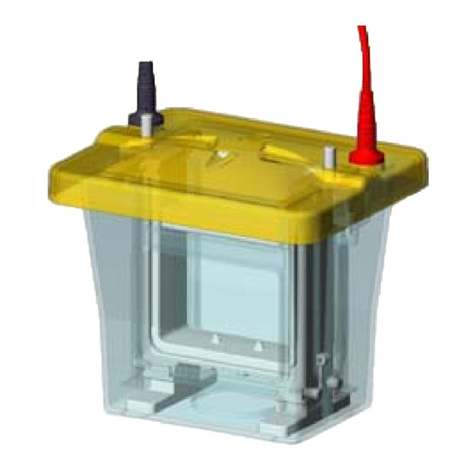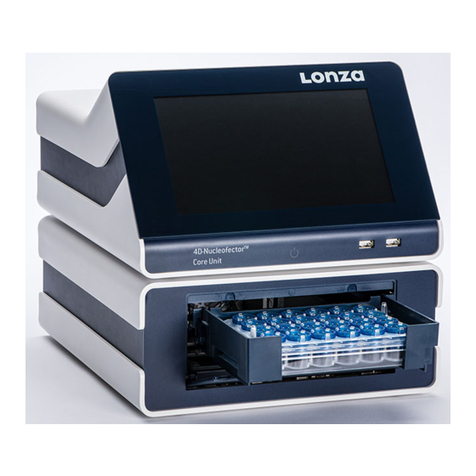
7
2.3 Safety instructions – please read carefully
This symbol means that there is a risk of electric shock.
An electric shock could cause death or personal injury.
The HT Nucleofector™ system has been certified by international
safety standards and is safe to use when operated in accordance with
this manual.
Only use the HT Nucleofector™ power supply in connection with the
HT Nucleofector™ plate handler. Under no circumstances should it be
connected to any other device delivering high-voltage electrical impulses.
The system is designed to deliver variable high-voltage impulses for the
purpose of introducing substrates into eukaryotic cells.
These electrical impulses can be deadly.
Therefore, use this system with care and take the following
precautions:
–
Only use the system once you have read and understood the
HT Nucleofector™ manual. The manual should be accessible to all users.
Make sure that each potential user reads and understands it.
– Set up the system in a dry place. Avoid spilling liquid onto or into the
HT Nucleofector™ power supply or the HT Nucleofector™ plate handler.
Do not use the system if any components are wet.
– Place the HT Nucleofector™ system components on top of a safe, level
and stable table or bench.
–
Before connecting/disconnecting any of the interface cables between
the HT Nucleofector™ plate handler and the HT Nucleofector™ power
supply, ensure that the HT Nucleofector™ power supply is switched
o and the power cable is removed from the power inlet.
–
Prevent sudden impacts and vibration while moving and transporting
system components.
–
Only use HT Nucleofector™ devices in conjunction with the HT
Nucleofector™ software.
–
Standard Nucleofector™ solutions and the Nucleofector™ solutions
used for the HT Nucleofector™ are not compatible.
– Do not use solutions or plates from any source other than Lonza.
–
Unpack the 384-well Nucleocuvette™ plates immediately before the
experiment. Make sure that the outer contact areas are dry.
–
Always place the lid onto the 384-well Nucleocuvette™ plate before
transferring it to the HT Nucleofector™ plate handler.
– Safety may be compromised if any uid has been spilled in the close
vicinity of the HT Nucleofector™ system. Ensure that no uid comes
into contact with or enters the system components. If any uid has
been spilled in the close vicinity of or onto the HT Nucleofector™ plate
system, contact Lonza scientic support for advice on precautions to
be taken before further use.
–
Do not open the device housing. Under no circumstances should circuit
components be interfered with, as they can deliver an electric shock
even when the system is not in operation.
– Do not alter the device in any manner.
–
Do not use the device if the insulation of the high voltage cable
connecting the plate handler and the power supply is damaged.
–
Do not use the device if any of the housing parts or covers are missing.
– Do not detach any of the housing parts or covers.
– Do not expose the device to a humid environment.
–
Do not expose the device to direct sunlight or place the instrument
in a hot environment.
–
Under no circumstances plug the high-voltage cables of the
HT Nucleofector™ plate handler into external electrode sockets of
any device other than the HT Nucleofector™ power supply. Use of a
device from any source other than Lonza will invalidate all warranty
and liability claims.
–
Do not use lids other than those provided with the 384-well
Nucleofector™ kits as the system is calibrated to the supplied lids.
Other lids may cause damage to the system.
–
Do not obstruct any moving parts, e.g. the plate carousel of the
HT Nucleofector™ plate handler.
–
Do not move the HT Nucleofector™ plate handler if a 384-well
Nucleocuvette™ plate is inside the device. Moving the plate handler
may cause sample uid from the plate to spill into the device.
–
Never place any foreign object onto the device or onto the plate
carousel. If a foreign object has entered the HT Nucleofector™ plate
handler, the safety of the device may be compromised. Contact
Lonza scientic support for advice on precautions to be taken before
further use.
–
The device is not approved for use in re- or explosion-endangered
areas, or for use with inammable or explosive media.
–
If any component of the HT Nucleofector™ system has been damaged,
ensure that the HT Nucleofector™ system cannot be used (e.g. by
disconnecting the HT Nucleofector™ power supply), and contact Lonza
scientic support for assistance.
– Service shall only be performed by personnel authorized by Lonza.
– Handling of device parts that may be contaminated by samples shall
always be performed with protective gloves and any disposal of such
parts must be according to federal, state or local procedures for clinical
waste handling and disposal. Use secure leak-proof containers and
avoid unprotected handling of such parts.
Note: Lonza disclaims all warranties expressed or implied and shall in no event be liable
for any kind of damages caused by or arising out of any operation or use in violation of the
safety and handling instructions above.
2

































